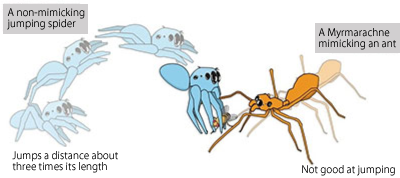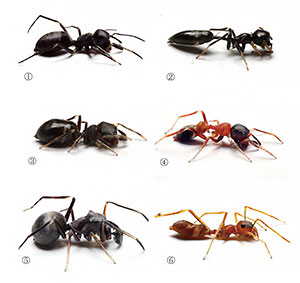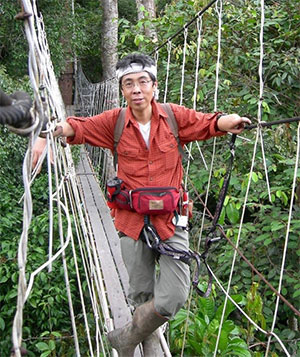News
Too Good at Their Job! Spiders That Mimic Ants Can Lose Jumping and Prey-Capturing Abilities Updated in December 2020
Associate Professor Yoshiaki Hashimoto (University of Hyogo / Museum of Nature and Human Activities, Hyogo Prefecture), a research member of SATREPS's environmental and energy project “Development of Management Systems for Multiple Utilization of Biodiversity in the Tropical Rainforests at the Protected Areas in Sarawak” (Research Leader: Professor Itioka Takao, Kyoto University and Ms. Runi Sylvester Pungga, Forest Department Sarawak), which started in June 2019, found that the cost to the jumping spider (Myrmarachne) of better mimicking ants was a reduction in its jumping power and prey-capturing ability. The jumping spiders mimic ants in order to protect themselves from foreign enemies.
Assoc. Prof. Hashimoto's research team collected seven species of ant-mimicking Myrmarachne (86 individuals) that inhabit Thailand and Malaysia's Borneo Island, plus 12 genera of jumping spiders that do not mimic (70 individuals). The morphology was measured using a method called “geometric morphological measurement”. In order to compare the two types of spiders’ predation abilities, the team photographed each individual preying on a small fly (about 2 mm in length) using a video camera, and measured the jumping distance and the success rate of capturing prey.
From the measurement results, it was found that the non-mimicking jumping spider leaped a distance of about three times its body length when catching its prey. On the other hand, the Myrmarachne spider could only jump as far as its body length at the most, with some individuals hardly able to jump at all. It was also found that the prey-catching success rate for the ant-mimicking Myrmarachne significantly decreased as its jumping power diminished.

Furthermore, among the mimicking genus of Myrmarachne, the one with a slender and more constricted body had lower jumping power and less success in catching prey. In other words, it was found that even within the genus Myrmarachne, the degree of decreased jumping power and prey-catching abilities differed depending on what kind of ant they were mimicking.
So far, more than 200 species of Myrmarachne have been identified around the world. It is known that all protect themselves from enemies by mimicking ants. However, we did not know much about the disadvantages that Myrmarachne spiders can suffer as a result of their mimicry. This research found that the delicate mimicry employed by Myrmarachne spiders has a high defense effect, but it is a double-edged sword that greatly reduces their original jumping power and predatory ability.
In this project, the team plans to collect 2D and 3D images as well as video data of the genus Myrmarachne taken by Assoc. Prof. Hashimoto, and to incorporate them in a database. In the future, they plan to accumulate clear image data, video data, and CT images of various species on the database. Thiscollection would become a biodiversity information platform that researchers in each country can refer to in the future.

①Myrmarachne acromegalis, ②M. cornuta, ③M. hashimotoi, ④ M. melanocephala, ⑤ M. maxillosa, ⑥ M. plataleoides

Original article published in JST News & Topics
Translated by SSC Secretariat







